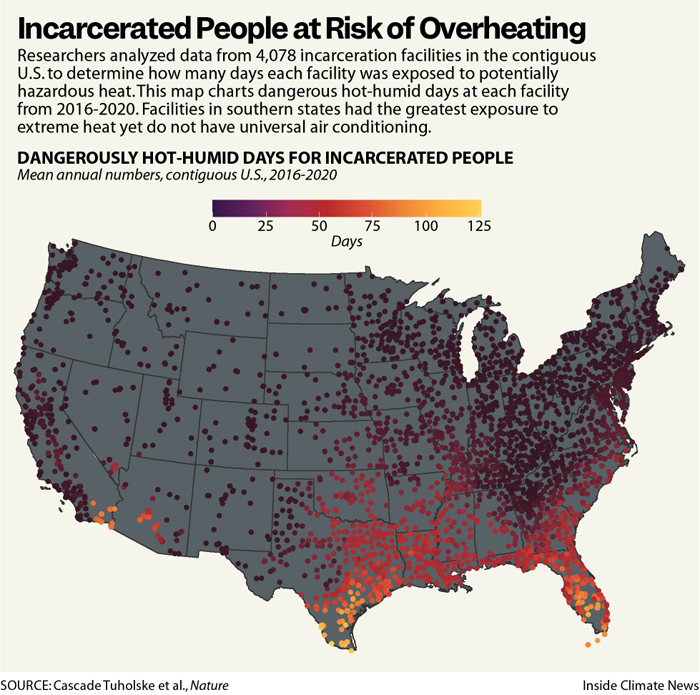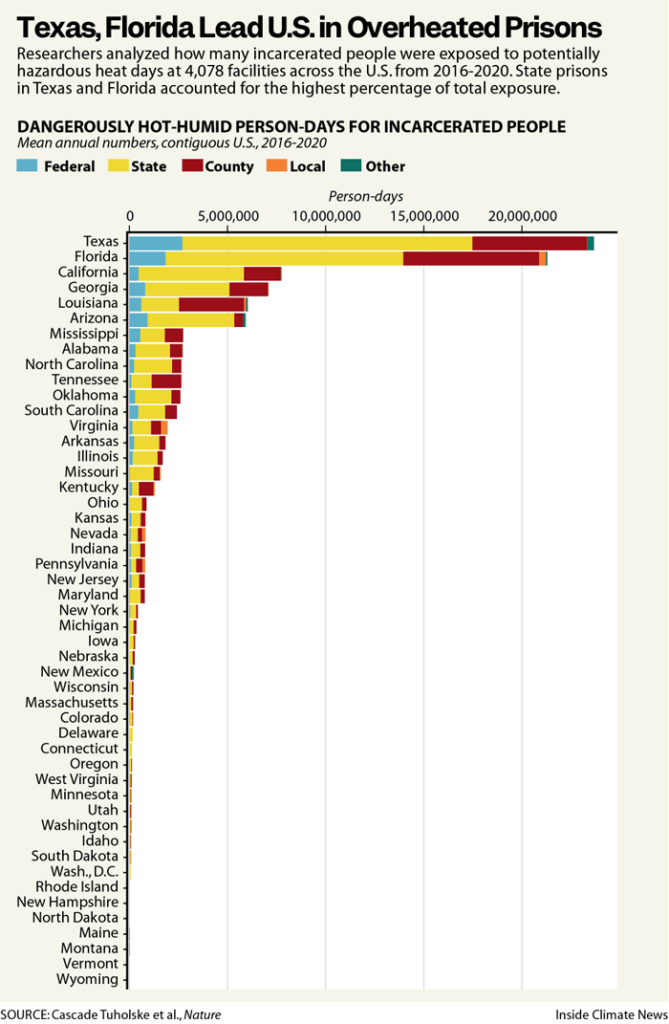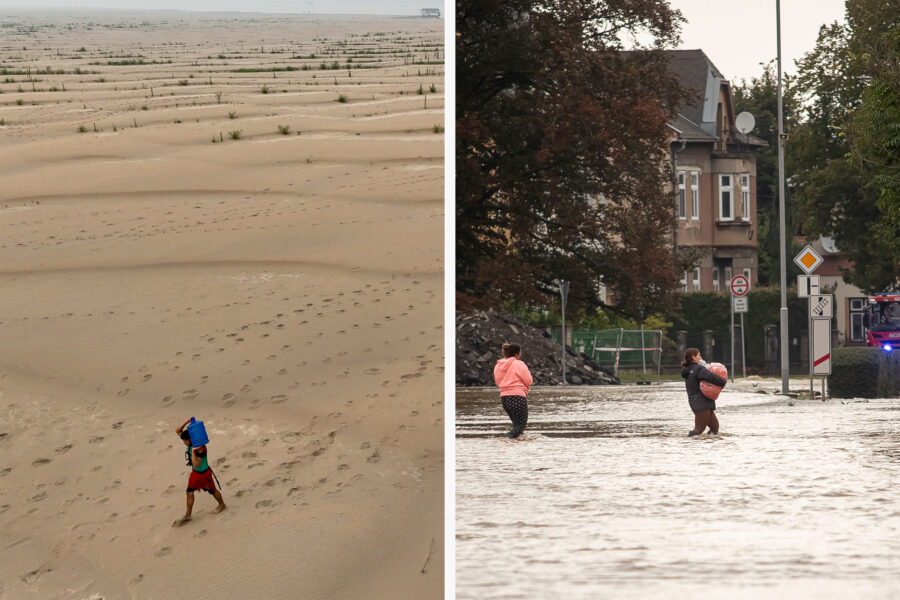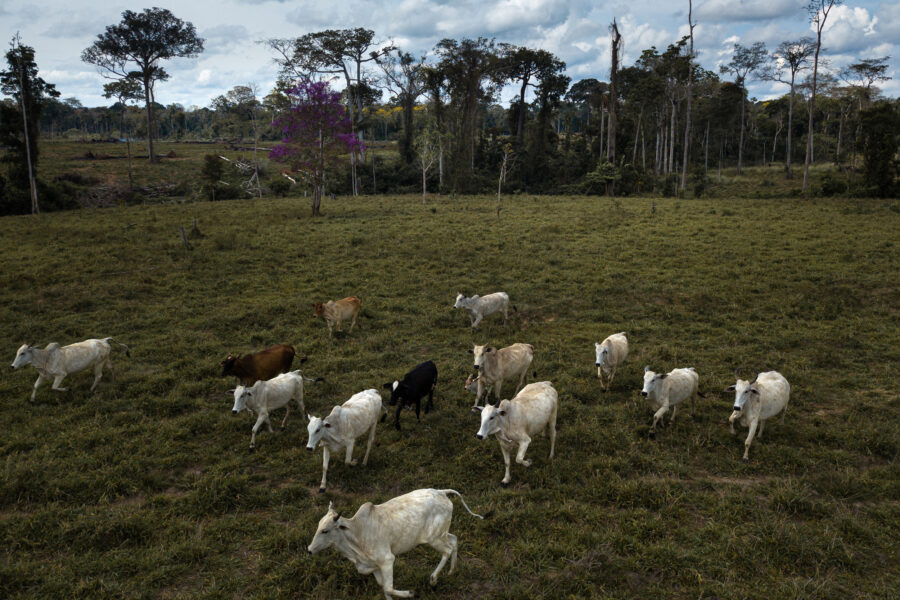US Prisons and Jails Exposed to an Increasing Number of Hazardous Heat Days, Study Says
Marci Simmons thinks back to her days in a Texas state prison as a cruel game of psychological planning for the summer. “In April, you start preparing yourself for the heat,” she said. “Towards the end of May, when it starts to get hot, you start telling yourself, ‘OK, it’s only four months of this really bad heat.’ And then you kind of count down in your mind. It’s a mental game of survival.”
Simmons was incarcerated in Texas state custody for more than a decade. She did time in the Dr. Lane Murray Unit, a state-run women’s prison in Gatesville—one of many such facilities nationwide that does not have air conditioning in the living spaces. To keep cool on hot days, she and other women would lie on their cell floors in puddles of water drawn from the sinks.
She said she wasn’t always able to track indoor temperatures because maintenance workers kept a piece of electrical tape over the dorm thermostat to hide the temperature readings. But one scorching day in the summer of 2020, Simmons removed the electrical tape using the sticky sides of two maxi pads that she had attached to the end of a broom. The temperature read 136 degrees. “I thought, well, this is why they didn’t want us to know,” she said.
Explore the latest news about what’s at stake for the climate during this election season.
A study published in March in the journal Nature Sustainability puts her experiences into nationwide context. Evaluating the heat exposure of more than 4,000 prisons, jails and immigration detention facilities across the U.S. since the 1980s, researchers found that the number of hot days per year increased at over 1,000 facilities—mainly in the South. They found the states of Texas, Florida, Arizona and Louisiana had the most exposure to potentially hazardous heat days—yet none provide universal access to air conditioning in state-run prisons.
Overall, state prisons in Texas and Florida had the greatest exposure to hazardous heat, the researchers found, accounting for 52 percent of total exposure to hazardous heat days, despite holding 12 percent of America’s incarcerated population. The researchers say the study illuminates the urgency of improved infrastructure and policies to keep incarcerated people safe from extreme heat hazards that they cannot escape.
Inspiration for the research came from the stories of incarcerated people that are published every summer in the media, said Robbie Parks, an environmental health scientist at Columbia University who co-authored the study. “People are dying without any kind of recourse to cooling. That inspired us to try and understand, ‘What is the actual heat exposure to incarcerated people? And what is the disparity compared with the rest of the country?’” he said. “Of course, the climate is changing. But it turns out that carceral facilities are located in places which are actually biased toward hotter temperatures.”

To conduct the study, researchers pinpointed the location and population of every prison, jail and immigration detention center in the U.S. using data from the U.S. Department of Homeland Security. They evaluated heat exposure at those locations using weather data recorded from 1982 to 2020 by researchers at Oregon State University. They then compared temperatures at those locations to temperatures elsewhere.
The researchers defined potentially hazardous heat days according to a standard used by the U.S. National Institute for Occupational Safety and Health (NIOSH) called “wet bulb globe temperature,” which accounts for a variety of factors, like humidity and air movement, to measure heat-related stress on workers’ bodies. NIOSH defines the maximum wet bulb globe temperature as 28 degrees Celsius, or 82.4 degrees Fahrenheit, for workers performing sedentary tasks with moderate levels of physical activity. (When temperatures increase above this threshold, worker accidents increase, according to a 2016 NIOSH report.)
The researchers found that 118 carceral facilities, mainly in southern California, Arizona, Texas and Florida, experienced an average of 75 days or more per year when the temperature exceeded NIOSH’s hazardous temperature threshold. Air conditioning is not universally available in those facilities, and some rely on evaporative cooling systems which are not as effective, according to the researchers.
They also found that carceral facilities are disproportionately exposed to hazardous heat days when compared with other areas of the U.S. Arizona, California and Nevada ranked as the top three states with the greatest temperature disparities between areas with and without carceral facilities. While climate change is certainly a driving force, the locations of these facilities are also a factor, the researchers say. Prisons and jails are often built where land is cheap and the local community sparse. Historically, that has tended to be in isolated deserts or swampy areas.

Ladd Keith, an urban planner at Arizona State University who studies the health risks of extreme heat, said the study is significant in that it examines the entire U.S. incarceration system, rather than a single state or single type of prison. “I think it paints a really holistic picture of heat hazards to incarcerated individuals,” he said.
Other studies have evaluated the environmental exposure of incarcerated populations within specific states. A 2023 study from the University of Colorado found that the majority of incarcerated people in that state are at risk of exposure to extreme heat, among other environmental hazards. A 2022 study led by a Brown University researcher found that the Texas prisoner death rate is 30 times the national average, likely due to heat-related deaths and lack of air conditioning.
The researchers noted that the risks of extreme heat exposure may be especially severe for incarcerated people with mental illnesses, as many psychiatric medications can impair the body’s ability to regulate heat. According to the U.S. Department of Justice, about 43 percent of people in state prisons reported a history of mental health issues.
The next step in the research, Parks said, is to map out indoor cooling systems in carceral facilities nationwide, along with heat-related deaths and illnesses that have been recorded at those facilities. The risk factors for heat-related death or illness must be assessed as well. “We want to know what we can modify in the environments of prisons and jails as they exist currently to actually alleviate the potential indoor heat risk,” he said.
Recent legal scholarship has argued that, as climate change worsens conditions in U.S. carceral facilities, constitutional protections against cruel and unusual punishment may be violated. Yet incarcerated people may have few effective means of seeking justice for such violations, scholars have written, as federal courts, particularly in the South, have not historically been sympathetic to incarcerated people presenting claims of cruel conditions.
Simmons said she filed formal complaints to the prison system every summer over 10 years, asking for relief from the extreme heat. “They just said there was nothing they could do,” she said. “It was very ineffective.”
Now, she receives letters from people inside who tell her about the many ways they try to survive—like stopping their psychiatric medications, which have heat warning labels.
Simmons said she was lucky to have been incarcerated without any preexisting conditions that could increase her risk of heat-induced illness. Just the same, she said, “I thought, ‘I’m just going to die,’ because it was that bad.”
Share this article
Disclaimer: The copyright of this article belongs to the original author. Reposting this article is solely for the purpose of information dissemination and does not constitute any investment advice. If there is any infringement, please contact us immediately. We will make corrections or deletions as necessary. Thank you.








